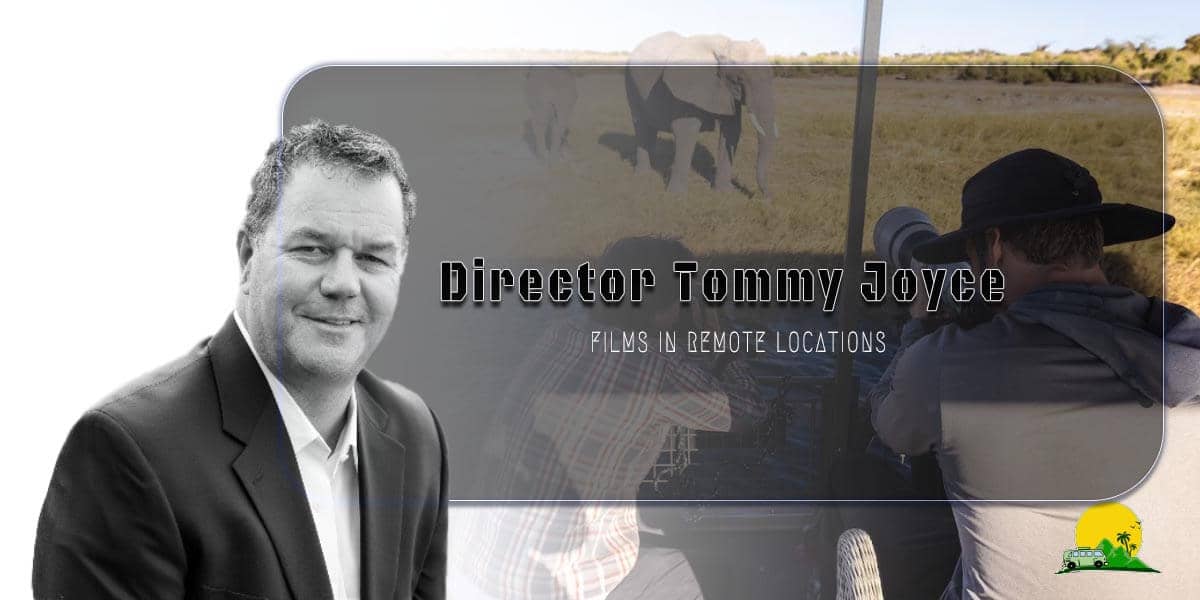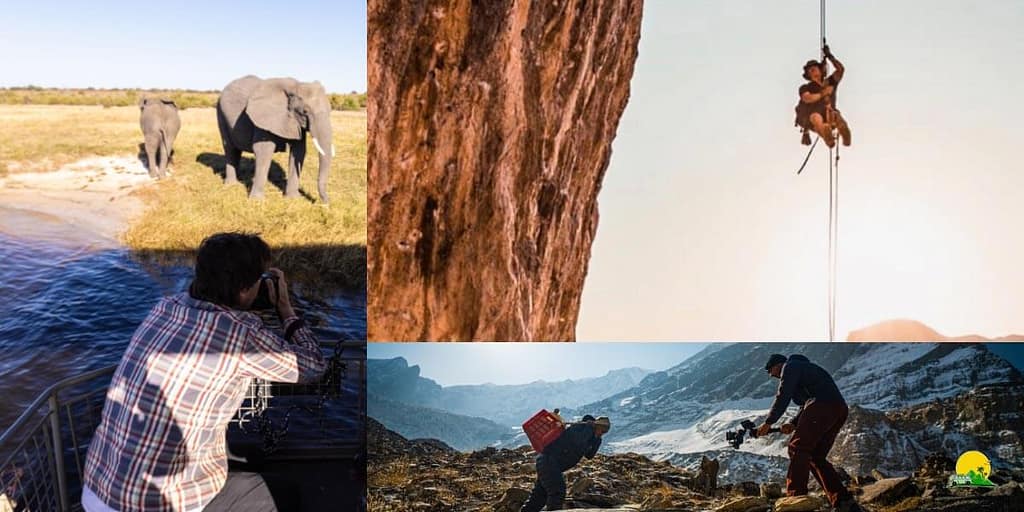What an Award-Winning Director, Tommy Joyce Films in Remote Locations

What an Award-Winning Director, Tommy Joyce Films in Remote Locations
Filmmaker Tommy Joyce has made a career of capturing visually stunning stories in some of the most extreme environments on Earth. Through his work, Joyce has gained a reputation as a master of off-grid filmmaking, able to produce high-quality productions under challenging conditions. His body of work has taken him to locations as diverse as Antarctica’s frozen coasts, the Himalayas’ towering peaks, and the Sahara’s scorching deserts. Through perseverance, careful planning and technical expertise, Joyce has unveiled movie magic in mysterious corners of the world that few ever see.
index
ToggleA Passion for Visual Storytelling
To understand how Joyce found his calling, we must first explore the origins of his passion for visual storytelling. He was raised in Boulder, Colorado, where outdoor pursuits like skiing, mountain biking and hiking were a big part of life. Joyce was naturally curious from a young age and began documenting his friends’ adventures with a camera. This sparked a creative spark that would later blossom into his filmmaking career.
After graduating high school, Joyce met renowned adventure photographer Keith Ladzinski, who took him under his wing. Ladzinski helped nurture Joyce’s skills and introduced him to professional production work. Through assisting Ladzinski’s shoots worldwide, Joyce gained invaluable hands-on experience, shaping him into a talented visual storyteller. By 2021, the two had formed a successful film production partnership called Triage Creative.
For Joyce, the true joy of filmmaking lies in its ability to inspire appreciation for wild places and motivate environmental stewardship. He is drawn to locations that showcase untamed natural beauty and habitats needing protection. Whether capturing the grace of wildlife or stories of human resilience, Joyce’s films aim to deepen connections to the natural world. This higher purpose of using his skills and platform to celebrate the planet continues to drive his adventurous career path.
Braving Harsh Environments
A defining aspect of Joyce’s work is his willingness to take on productions in some of the most unforgiving environments on Earth. The extreme conditions limit his technical and logistical skills, yielding rarely-seen landscapes and authentic human stories. Some of Joyce’s most memorable assignments include:
Niger, Sahara Desert: Joyce endured blistering 49°C heat while filming a documentary on dinosaurs. Finding even a sliver of shade was crucial to survival.
Dhaulagiri, Nepal: At 6,700m altitude, Joyce spent two nights in a tent scouting climbers up the treacherous mountain. Bitter cold and scarce drone batteries tested his endurance.
Antarctic Peninsula: Sub-zero temperatures and unpredictable weather made capturing the rugged coastal scenery a frozen challenge.
Okavango Delta, Botswana: Dense swamps and plentiful predators presented dangers while documenting the thriving wildlife.
Kalymnos Island, Greece: Cliffs and lack of infrastructure created risky conditions for climbing films.
Such adversity requires meticulous planning, adaptive problem-solving and a willingness to endure discomfort. For Joyce, braving nature’s extremes draws out authentic human stories, and rarely witnessed natural events make his films stand out.
Mastering Logistics in Remote Lands

To consistently deliver high-quality productions in remote fields, Joyce has honed a rigorous approach to planning, equipment selection and on-location operations. Here are some of his logistical strategies:
Research – Joyce spends months learning about a location’s geography, climate, cultures, and flora/fauna to anticipate challenges and opportunities.
Permissions – Local regulations, sensitive areas and subject consent are addressed through extensive coordination.
Supplies – Only essential durable gear is brought. Joyce relies on local expertise and markets to replenish perishable items.
Transportation – Vehicles are chosen based on terrain, while pack animals assist in wilderness areas.
Accommodation – From tents to village homes, Joyce finds a safe, basic shelter near filming sites.
Power/Connectivity – Redundant batteries, solar panels and satellite devices ensure uninterrupted filming and data transfer.
Contingencies – Alternative filming plans, multiple equipment versions, emergency supplies, and travel insurance provide flexibility.
Joyce can focus fully on storytelling once on location by meticulously addressing logistics. His proficiency in remote operations management is a big reason for his success, even in challenging environments.
Overcoming Technical Challenges
While thorough planning helps, the unpredictable nature of remote filming locations means the equipment must withstand punishing conditions. Joyce credits rigorous equipment testing and redundancy strategies for overcoming technical challenges:
Cameras – Industrial-grade cameras like the Arri Alexa Mini withstand dust, moisture, shocks and wide temperature ranges.
Lenses – Professional zoom and prime lenses from companies like Canon and Sigma perform under extreme weather.
Gimbals – The Movi M5 gimbal stabilizes shots on land and from drones over rugged terrain.
Drones – Mavic 3 and Inspire 2 drones with spare batteries and parts capture aerial beauty safely.
Audio – Sound devices like the Zoom F6 handle noise from wind and wildlife. Lavalier and shotgun mics adapt to subjects and shots.
Power – Anker’s solar panels and batteries keep devices running for days without mains power.
Data – Satellite transmitters and large-capacity hard drives ensure rushes are backed up and transferred despite connectivity issues.
Durability – Military-grade cases, rain covers, and lens heaters protect all equipment from the elements.
Through extensive testing under real conditions, Joyce has curated the ideal toolset. His technical acumen is a huge asset for overcoming obstacles in remote filming environments.
Building Rapport with Subjects

A hallmark of Joyce’s films is their ability to capture authentic human stories amidst natural backdrops. This requires gaining the trust of local subjects who open their lives for portrayal. Joyce’s approach focuses on respect, rapport and flexibility:
- Research ensures an understanding of cultural norms to avoid offences.
- Initial contact is made through local fixers and community leaders when possible.
- Clear expectations are set around content, privacy issues and potential impacts.
- Filming only begins after subjects seem comfortable, with the option to halt anytime.
- Casual social interactions outside of filming help build familiarity and comfort.
- Subject needs like breaks, meals and accommodations are prioritized over shots.
- Raw footage is shared for feedback and final cut approval when requested.
By taking a respectful, collaborative approach focused on the human element above all, Joyce consistently earns the cooperation needed to tell compelling character-driven stories even in remote areas.
Overcoming Adversity Creatively
While thorough planning can mitigate many challenges, remote filming will inevitably encounter unpredictable obstacles. Here, Joyce’s ability to adapt creatively is what allows productions to succeed despite adversity:
- Equipment failures are addressed through alternative camera angles, available lighting or postponing shots.
- Inclement weather often means shelving outdoor shots and focusing indoors or in temporary structures.
- Injuries may require shifting subject roles, adding safety precautions or altering the story focus.
- Local issues like political unrest could inspire a shift to related but less sensitive topics.
- Resource limitations spur innovative solutions like generating power from stream water or makeshift mounts.
- Wildlife dangers are avoided by changing locations or times of day instead of risky close-ups.
By embracing flexibility and utilizing every available option, Joyce turns what could halt other productions into opportunities for creative problem-solving. This resilience is why he consistently delivers, even in filmmaking’s most unpredictable environments.
Sharing Knowledge and Inspiring Others
Beyond his own body of work, Joyce aims to spread knowledge gained from extensive off-grid experience. He shares advice through workshops, social media and industry mentorship to help others pursue their filmmaking dreams:
- Rely on local expertise and never endanger crews due to lack of preparation.
- Test all equipment exhaustively and bring redundant gear suitable for the worst conditions.
- Prioritize safety, permissions and cultural awareness above all creative goals.
- Scouting remotely via local contacts and satellite imagery aids planning immensely.
- Backup all footage continuously to multiple secure sources despite connectivity.
- Promote an attitude of adaptability and problem-solving rather than frustration.
- Tell authentic stories that respect and benefit local people and environments.
By empowering new generations of adventurous storytellers, Joyce hopes to expand impactful visual communications from remote areas often overlooked. He aims to inspire greater global understanding and conservation efforts through off-grid cinematic works.
Pushing Creative Boundaries
Even after establishing himself as a leader in his field, Joyce’s drive to learn continues, propelling him to new heights. Upcoming projects include utilizing advanced technologies like virtual and augmented reality to immerse audiences in rarely-seen landscapes. Through constant innovation, he strives to push the creative boundaries of off-grid filmmaking and develop untapped potential:
- Experimenting with mini-drones allows access to views previously unobtainable.
- Testing the latest 360-degree cameras opens doors for immersive storytelling.
- Utilizing thermal cameras may unveil hidden animal behaviours in darkness or harsh weather.
- Livestreaming technology could bring remote wilderness experiences into classrooms.
- Artificial intelligence may automate complex tasks like editing to expand solo filmmaking possibilities.
Joyce also aims to pioneer new production techniques like developing renewable energy solutions for off-grid power and developing environmentally sustainable location practices. He continues collaborating with technical partners to shrink package sizes and extend the battery lives of cinema equipment.
Through constant innovation, Joyce hopes to expand his creative horizons and advance the entire field of off-grid filmmaking. His vision is for future generations to build upon lessons learned, pushing even farther into cinematic frontiers as technologies evolve. Joyce’s lifelong quest for visual storytelling shows no signs of slowing as he remains devoted to sharing untouched natural beauty and human triumph from Earth’s most remote regions.
Read More: Fall In Love With Magical Heart-Shaped Places Around The World
Final Thoughts
Through his work over decades, Tommy Joyce has cemented himself as the preeminent master of off-grid filmmaking. By overcoming extreme conditions, meticulously planning complex logistics and creatively adapting to obstacles, Joyce consistently delivers impactful productions from locations few thought possible. His technical expertise, collaborative approach to subjects, and passion for the natural world serve as an inspiration.
For aspiring off-grid filmmakers, Joyce’s experiences offer invaluable guidance. Even the most remote filming dreams can be achieved with thorough preparation, reliable equipment testing, cultural awareness training and a flexible problem-solving mindset. Joyce hopes to empower new generations of visual storytellers by pushing creative boundaries and sharing knowledge generously. As technologies evolve, his pioneering spirit will surely continue unveiling new frontiers in cinematic exploration for years to come.
Recent Posts
Contact Us
+1 437 499 4559










